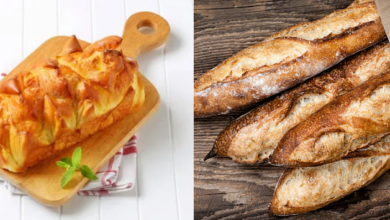Is Brioche Like Croissants? The Surprising Truth Revealed!
What To Know
- Croissant dough is rolled and folded into a crescent shape and baked on a baking sheet.
- Whether you prefer the richness of brioche or the flakiness of croissants, both pastries are sure to tantalize your taste buds and transport you to the heart of French culinary artistry.
- Both pastries are buttery, but croissants have a more pronounced buttery flavor due to the layers of butter in the dough.
The world of pastries is a vast and delectable one, with countless varieties to tantalize our taste buds. Two of the most beloved and iconic pastries are brioche and croissants. While both share a rich French heritage and a buttery, flaky texture, they also possess distinct characteristics that set them apart. In this culinary exploration, we will delve into the similarities and differences between brioche and croissants, examining their ingredients, textures, flavors, and the unique techniques used in their creation.
Ingredients: A Foundation of Flour, Butter, and Eggs
Brioche and croissants share a common foundation of ingredients, including flour, butter, eggs, and milk. However, the proportions and techniques used in combining these ingredients result in vastly different pastries.
- Brioche: Brioche dough is typically made with a higher proportion of butter and eggs compared to croissants. This creates a richer, more tender crumb with a slightly sweet flavor.
- Croissants: Croissants, on the other hand, have a higher proportion of flour and a lower proportion of butter. This results in a more layered, flaky texture with a slightly crispy exterior.
Texture: Layers, Flakes, and Tenderness
The texture of brioche and croissants is a defining characteristic.
- Brioche: Brioche has a soft, tender crumb with a slight chewiness. It is not as flaky as croissants but has a more open, airy texture.
- Croissants: Croissants are renowned for their flaky layers, created through a process called laminating. This technique involves alternating layers of dough and butter, which are then rolled and folded repeatedly. The result is a pastry that is both crispy and tender.
Flavor: Sweetness, Richness, and Buttery Delight
The flavors of brioche and croissants are as distinctive as their textures.
- Brioche: Brioche has a rich, buttery flavor with a hint of sweetness. The eggs and sugar in the dough contribute to its slightly sweet taste.
- Croissants: Croissants have a more pronounced buttery flavor with a subtle hint of saltiness. The layers of butter in the dough create a deep, savory richness.
Shaping and Baking: From Dough to Pastry Perfection
The shaping and baking techniques used for brioche and croissants further differentiate these pastries.
- Brioche: Brioche dough is typically shaped into round or oblong loaves and baked in a loaf pan. This results in a dense, compact pastry with a slightly crusty exterior.
- Croissants: Croissant dough is rolled and folded into a crescent shape and baked on a baking sheet. This creates the characteristic flaky layers and crispy exterior.
Serving and Enjoyment: A Culinary Canvas
Brioche and croissants are versatile pastries that can be enjoyed in a variety of ways.
- Brioche: Brioche is often served for breakfast or brunch, paired with jams, jellies, or fresh fruit. It can also be used to make French toast or bread pudding.
- Croissants: Croissants are typically enjoyed as a breakfast pastry, often paired with coffee or tea. They can also be filled with various ingredients, such as chocolate, almonds, or cheese.
Key Points: A Tale of Two Pastries
Brioche and croissants are both exceptional pastries that offer unique culinary experiences. While they share a common heritage and a buttery, flaky texture, their distinct ingredients, textures, flavors, and shaping techniques set them apart. Brioche, with its rich, tender crumb and slightly sweet flavor, is a perfect indulgence for those who prefer a more dense and flavorful pastry. Croissants, with their flaky layers, crispy exterior, and pronounced buttery flavor, are a delight for those who appreciate a lighter, more delicate pastry. Whether you prefer the richness of brioche or the flakiness of croissants, both pastries are sure to tantalize your taste buds and transport you to the heart of French culinary artistry.
What You Need to Know
Q: Which pastry is sweeter, brioche or croissants?
A: Brioche is slightly sweeter than croissants due to the higher proportion of eggs and sugar in the dough.
Q: Which pastry is more buttery, brioche or croissants?
A: Both pastries are buttery, but croissants have a more pronounced buttery flavor due to the layers of butter in the dough.
Q: Can I make brioche or croissants at home?
A: Yes, it is possible to make both brioche and croissants at home, but it requires time, patience, and careful attention to technique.

